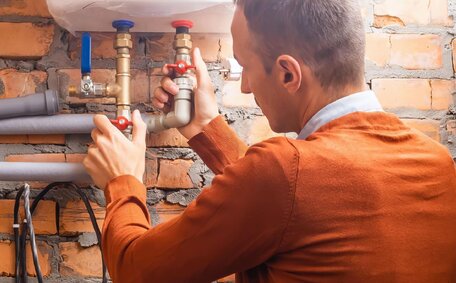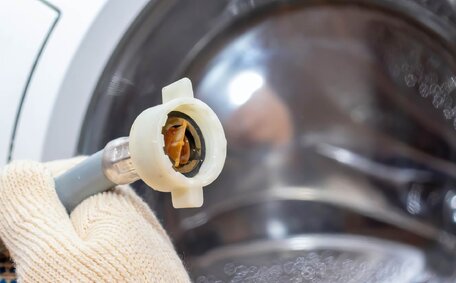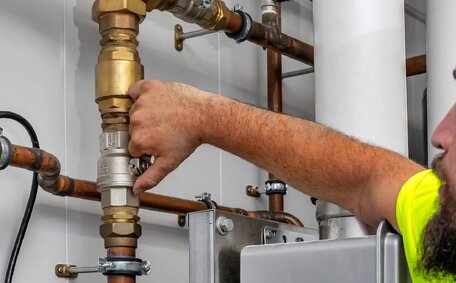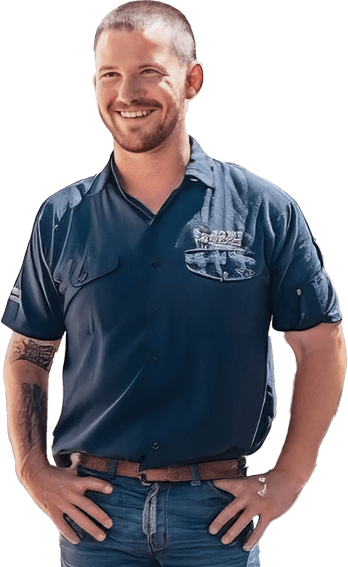What is Pipe Relining and How Does it Work?
Pipe relining is a cutting-edge technique that mends pipes beneath landscapes without excavation. By inserting a liner soaked in epoxy resin into the existing pipeline, it eliminates disruptive digging.
The resin-soaked liner adheres to the interior of your existing pipe, creating a strong new lining and restoring the pipe’s integrity and flow capacity with minimal intrusion.
The sewer pipe relining process enables plumbers to effectively rehabilitate old pipes and sewer pipes by inserting a liner into those made of materials like clay, iron, and concrete. This swift and reliable solution refurbishes pipes affected by cracks, leaks, and tree root damage, restoring their functionality. Pipe relining prevents landscape damage and is often more cost-effective than complete pipe replacement.
Comparing Pipe Relining Techniques: CIPP vs SIPP vs Others
There are several pipe relining methods professionals utilise, including the popular Cured-In Place Pipe (CIPP) and Spray In Place Pipe (SIPP), which can successfully repair the lines leading to your toilet.
Cured-In Place Pipe (CIPP) Relining
CIPP relining involves turning the existing structure inside out by inserting a resin-saturated felt liner into the damaged pipe and then curing it. The resin hardens, bonding to the existing structure and forming a new durable layer within the existing pipe.
CIPP offers many advantages, such as:
- Long track record and proven effectiveness
- Can reline pipes up to 36 inches diameter
- Good for offset joints or diameter changes
- Minimal excavation and property disruption
Spray In Place Pipe (SIPP) Relining
SIPP is effective for small pipes, involving an epoxy resin sprayed onto the interior of the damaged pipe with a rotating nozzle. It cures to form a smooth new barrier.
Benefits of SIPP include:
- Very fast curing times
- Can be used on smaller pipes down to 2 inches
- Seamless pipe joint connections
Other methods, including Close-Fit Lining and Modified Sliplining, offer unique advantages for specific repair scenarios. When choosing the most appropriate method, pipe size, the extent of the damage, and accessibility are considered to provide cost-effective options tailored to your situation.
Our team ensures that all methods are minimally invasive and economically viable, rejuvenating your pipes with negligible landscape disturbance.
Step-by-Step Process of Professional Pipe Relining
For successful pipe relining, ensure the procedure is conducted by skilled professionals using a meticulous, multi-step process:
1. Initial Pipe Assessment
The process begins with a comprehensive drain camera inspection to assess pipe conditions, pinpoint damage, and determine the optimal relining approach and custom liner design.
2. Pipe Preparation
Technicians clean the pipe interior using high-pressure water jets to remove blockages, prepare surfaces, and strip away old coatings, ensuring the liner bonds effectively.
3. Resin Saturation & Installation
The custom fabric liner tube, impregnated with epoxy resin through vacuum application, ensures a perfect fit. Expertly positioned into the pipe, air pressure may be used for inverting the liner in larger pipes.
4. Curing & Hardening
The resin is cured with hot water, steam, UV lamps, or ambient temperatures, without external pressure. It solidifies, fusing to the pipe walls, thus sealing cracks and enhancing structure.
5. Post-Lining Tests & Sealing
Technicians camera inspect the rehabilitated drains sewer pipes, conduct pressure tests for leaks, trim liner at each access point, and seal with hydrophilic gaskets to ensure waterproofing.
When executed with expertise, you can have your plumbing issues resolved by engaging our pipe relining experts, assured that this precise relining process renews pipes without need for property disruption.
Materials and Methods Used in Pipe Relining
There are several key materials and methods used in modern pipe relining applications:
Materials
PVC (Polyvinyl Chloride) - PVC is a popular thermoplastic resin liner material due to its durability, corrosion resistance, and affordability. This durability makes PVC suitable for pipes made to last, a key component in our variety of pipe relining solutions, ideal for a vast range of climates.
Epoxy Resin - Epoxy is the most common resin solution used to saturate the liner before installation. It bonds exceptionally well to various materials and cures rock-hard to renew structural stability.
Felt - Thick needled felt fabric is the typical liner material used. It holds resin well and flexes to navigate pipes.
Methods
Common pipe lining methods include:
- Inversion - The liner is inverted through the existing pipe using water or air pressure, allowing for seamless integration with the pipe structure.
- Pull-in - The liner is attached and literally inserted into the pipe.
- Spiral winding - Used on very large pipes, the liner is rotated while being continuously wound through the pipe.
When it comes to choosing the right pipe lining method and materials, professionals can expertly assess pipe size, extent of damage, and location accessibility. Professionals select the optimal repair methods, like epoxy resin with inversion lining for small indoor plumbing or PVC with pull-in lining for larger stormwater drain applications.
The variety of trenchless types pipe lining materials and methods allows effective repairs of all types of damaged sewer pipe.
When to Choose Pipe Relining Over Replacement
In many cases, drain relining is quite often a preferable alternative to traditional pipe replacement for addressing damaged pipes. Key factors to weigh include:
Extent of Damage
If a broken pipe presents isolated issues, like cracks or root intrusion yet remain structurally sound, relining is the optimal choice. It restores functionality affordably without replacement.
Environmental Impact
Relining triumphs over traditional pipe excavation methods, as it can preserve your yard and seamlessly reline your damaged pipes, thus minimizing property damage and disruption. Relining also stands out by producing less waste than other traditional methods of pipe replacement.
Cost & Downtime
To get your plumbing system refurbished, a typical pipe relining costs $80-250 per linear foot, while replacement runs $200-500 per foot. The relining process can take a mere 1-3 days, consuming far less time than traditional pipe repair would require.
Pipe Life Extension
Properly installed pipe liners withstand wear tear, lasting 50 years or longer and illustrating the lasting value of relining over replacement. Epoxy resins create a durable inner barrier.
In cases where relining service would suffice but complete pipe deterioration, collapse, or redesign requirements are present, total replacement becomes the last resort. Otherwise, there no pipe repair method is more environmentally friendly and cost-effective than trenchless pipe relining.
Maximizing the Benefits: Tips for Pipe Relining Success
To ensure your pipe relining project is completely successful and you maximise the benefits, here are some key tips to follow:
Choose an Experienced Provider
You can contact our pipe relining team, featuring dedicated relining specialists, who are experts in this field rather than offering broad plumbing services. Ask about years in business, specific training and industry affiliations. This expertise is vital where there’s no room for error.
Inspect the Full Extent of Damage
Make sure to contact our team to conduct a thorough camera inspection first to precisely locate all damage. Rushing ahead with partial information jeopardises success.
Understand the Process
Ensure you’re familiar with what pipe relining involves, including access points, equipment used, timelines, and any impact on use during the procedure. Transparency is key to avoid any unexpected issues.
Follow Post-Relining Instructions
Post-relining water use restrictions must be observed to allow the liner to cure properly without interruption from pressure changes.
Perform Preventative Maintenance
Annual drain cleanings and treatments for root intrusions extend the lifespan of the relined pipes and protect your home’s plumbing from subsequent damage. Early detection is vital to preserving the integrity of the system.
While pipe relining itself renew pipes very reliably when done properly, following these tips will ensure optimal results from your project.
Pipe Relining and Preventative Plumbing Maintenance
Pipe relining is a superior alternative to traditional repair methods and is suitable for various plumbing restorations. Combining pipe relining with regular preventative maintenance constitutes the best approach.
Proactive measures can prevent damage and expensive repair or relining needs in residential and commercial properties, such as:
- Conducting regular cleanings with rooter service
- Addressing minor drips and leaks promptly
- Regular debris removal from sinks, showers, and pipes
- Prompt treatment for root intrusions
Catching issues early makes them less likely to progress into bigger problems. This saves on costs over time compared to large repairs.
Regular maintenance extends the effectiveness and durability of relined pipes. Techniques such as drain cleaning mitigate risks, making them an essential component to any pipe repair replacement strategy that could otherwise undermine the relined pipes. Furthermore, yearly inspections help track the condition of your sewers.
Pairing scheduled upkeep with pipe relining offers a comprehensive approach to drain maintenance.
This strategy ensures long-term plumbing reliability and reinforces the value of plumbers as dependable service providers.






